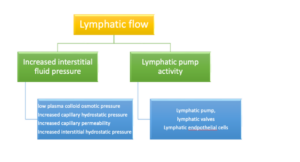Lymphatic system
Learning outcome 1.Discuss the functions of the lymphatic system.
The lymphatic system is a part of the immune system and has several important functions in the body, including:
- Maintaining fluid balance: The lymphatic system helps to regulate fluid balance by filtering excess fluid, waste products, and foreign substances from the tissues and returning it to the bloodstream.
- Absorbing fats: The lymphatic system helps absorb fat from the intestines and transport it to the bloodstream for energy use.
- Immune defense: The lymphatic system plays a crucial role in the body’s defense against infections and harmful substances. The fluid in the lymphatic system, called lymph, is filtered by lymph nodes and other tissues, where immune cells, such as lymphocytes, can remove harmful substances and initiate an immune response.
- Controlling inflammation: The lymphatic system is also involved in controlling inflammation by removing excess fluid and waste products from inflamed areas.
- Supporting overall health: The lymphatic system is essential for overall health, as it helps remove waste products and maintain fluid balance, supports immune function, and regulates inflammation.
Learning outcome 2.Describe the formation and components of the lymphatic system
Lymph is a fluid that is derived from interstitial fluid and has a similar composition, although its composition can vary depending on the tissues it is formed in. The liver is a major contributor to lymph formation, accounting for about 2/3 of it, and lymph from the liver has a protein content of approximately 5-6g/dL. Other tissues have a protein content of 2-3 g/dL and the thoracic duct, which collects lymph from different parts of the body, has a protein content of 3-4 g/dL.
The formation of lymph occurs when the balance of Starling’s forces causes fluid to filter into the interstitium. This fluid is reabsorbed at the venous side, with the remaining fluid becoming interstitial fluid and flowing into lymphatic vessels to be cleared.
The flow of lymph is facilitated by the endothelial cells of the lymphatic capillary, which are attached by anchoring filaments. The edges of the cells overlap, forming a minute valve. When interstitial fluid pressure is raised, the valve can open and fluid can flow directly into the lymphatic capillary. The accumulation of lymph in the capillary prevents the flap from opening.
Overall, the composition of lymph is greatly influenced by the tissue from which it is formed. The electrolytes and water content of lymph is similar to the extracellular fluid (ECF) and it contains cell debris and products of tissue metabolism.
Factors affecting formation of lymph:
